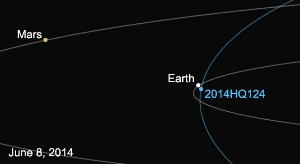Jun 9 2014
A newfound asteroid will safely pass Earth on June 8 from a distance of about 777,000 miles (1.25 million kilometers), more than three times farther away than our moon.
 This diagram shows the orbit of asteroid 2014 HQ124, and its location relative to Earth on June 8. Image Credit: NASA/JPL-Caltech
This diagram shows the orbit of asteroid 2014 HQ124, and its location relative to Earth on June 8. Image Credit: NASA/JPL-Caltech
Designated 2014 HQ124, the asteroid was discovered April 23, 2014, by NASA's NEOWISE mission, a space telescope adapted for scouting the skies for asteroids and comets. The telescope sees infrared light, which allows it to pick up the infrared glow of asteroids and obtain better estimates of their true sizes. The NEOWISE data estimate asteroid 2014 HQ124 to be between 800 and 1,300 feet (250 and 400 meters).
"There is zero chance of an impact," said Don Yeomans, manager of NASA's Near-Earth Object Program Office at NASA's Jet Propulsion Laboratory in Pasadena, California. "In fact, it's fairly common for asteroids to pass near Earth. You'd expect an object about the size of 2014 HQ124 to pass this close every few years."
More than one hundred follow-up observations from NASA-funded, ground-based telescopes and amateur astronomers were used to pin down the orbit of the asteroid out to the year 2200, during which time it poses no risk to Earth. Its trajectory will continue to be recalculated past that time frame as additional observations are received.
Yeomans said that 2014 HQ124 is a good target for radar observations using NASA's Deep Space Network antenna at Goldstone, California, and the Arecibo Observatory in Puerto Rico, shortly after the closest approach on June 8. Radar measurements of asteroid distances and velocities often enable computation of asteroid orbits much further into the future than otherwise known.
2014 HQ124 is designated a "potentially hazardous asteroid," or PHA, which refers to those asteroids 460 feet (140 meters) in size or larger that pass within 4.6 million miles (7.4 million kilometers) of Earth's orbit around the sun. There are currently 1,484 known PHAs, but none pose a significant near-term risk of impacting Earth.
"Because NEOWISE is a space telescope observing the dawn and twilight sky at infrared wavelengths, it is particularly good at finding large NEOs that make relatively close passes to Earth," said Amy Mainzer, the principal investigator of NEOWISE at JPL. "Using infrared light, we can estimate the object's size, and we can tell that it reflects a fair amount of light. That means it's most likely a stony object."
NASA detects, tracks and characterizes asteroids and comets passing close to Earth using both ground- and space-based telescopes. The Near-Earth Object Program, commonly called "Spaceguard," discovers these objects, characterizes a subset of them and identifies their orbits to determine if any could be potentially hazardous to our planet. To date, U.S. assets have discovered more than 98 percent of the known near-Earth objects.
Along with the resources NASA puts into understanding asteroids, it also partners with other U.S. government agencies, university-based astronomers, and space science institutes across the country that are working to find, track and understand these objects better, often with grants, interagency transfers and other contracts from NASA. In addition, NASA values the work of numerous highly skilled amateur astronomers, whose accurate observational data helps improve asteroid orbits after they are found.
JPL manages the Near-Earth Object Program Office for NASA's Science Mission Directorate in Washington. JPL is a division of the California Institute of Technology in Pasadena.
More information about asteroids and near-Earth objects is available at: http://neo.jpl.nasa.gov/ http://www.jpl.nasa.gov/asteroidwatch
Twitter updates are at: http://www.twitter.com/asteroidwatch